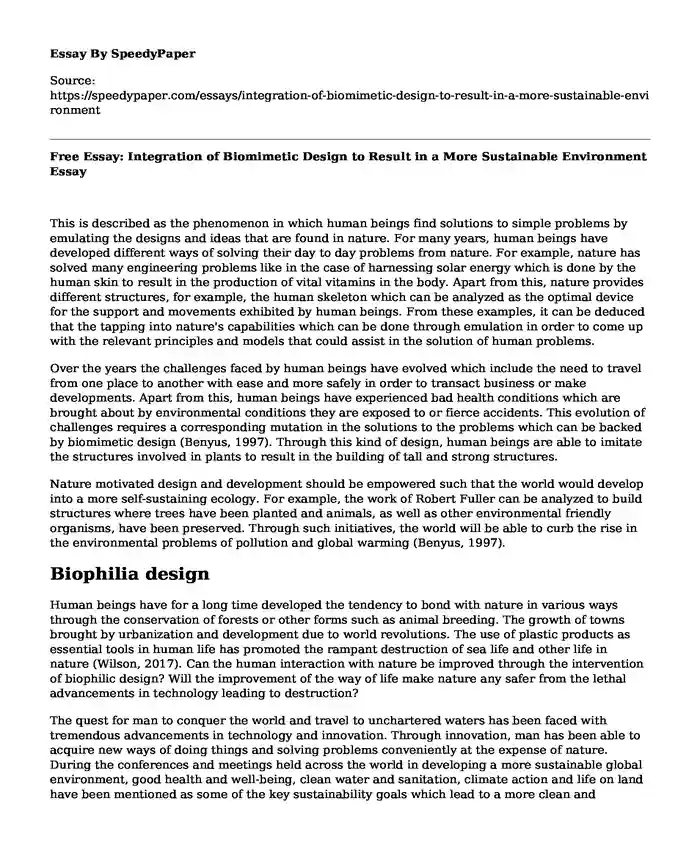
| Type of paper: | Essay |
| Categories: | Environment Design |
| Pages: | 3 |
| Wordcount: | 701 words |
This is described as the phenomenon in which human beings find solutions to simple problems by emulating the designs and ideas that are found in nature. For many years, human beings have developed different ways of solving their day to day problems from nature. For example, nature has solved many engineering problems like in the case of harnessing solar energy which is done by the human skin to result in the production of vital vitamins in the body. Apart from this, nature provides different structures, for example, the human skeleton which can be analyzed as the optimal device for the support and movements exhibited by human beings. From these examples, it can be deduced that the tapping into nature's capabilities which can be done through emulation in order to come up with the relevant principles and models that could assist in the solution of human problems.
Over the years the challenges faced by human beings have evolved which include the need to travel from one place to another with ease and more safely in order to transact business or make developments. Apart from this, human beings have experienced bad health conditions which are brought about by environmental conditions they are exposed to or fierce accidents. This evolution of challenges requires a corresponding mutation in the solutions to the problems which can be backed by biomimetic design (Benyus, 1997). Through this kind of design, human beings are able to imitate the structures involved in plants to result in the building of tall and strong structures.
Nature motivated design and development should be empowered such that the world would develop into a more self-sustaining ecology. For example, the work of Robert Fuller can be analyzed to build structures where trees have been planted and animals, as well as other environmental friendly organisms, have been preserved. Through such initiatives, the world will be able to curb the rise in the environmental problems of pollution and global warming (Benyus, 1997).
Biophilia design
Human beings have for a long time developed the tendency to bond with nature in various ways through the conservation of forests or other forms such as animal breeding. The growth of towns brought by urbanization and development due to world revolutions. The use of plastic products as essential tools in human life has promoted the rampant destruction of sea life and other life in nature (Wilson, 2017). Can the human interaction with nature be improved through the intervention of biophilic design? Will the improvement of the way of life make nature any safer from the lethal advancements in technology leading to destruction?
The quest for man to conquer the world and travel to unchartered waters has been faced with tremendous advancements in technology and innovation. Through innovation, man has been able to acquire new ways of doing things and solving problems conveniently at the expense of nature. During the conferences and meetings held across the world in developing a more sustainable global environment, good health and well-being, clean water and sanitation, climate action and life on land have been mentioned as some of the key sustainability goals which lead to a more clean and resourceful environment.
Biophilia in this context is discussed not only as a suggested theory but a way of life. Biophilia can be incorporated in the day to day lives from the colour of the mugs of tea to the design of tall buildings that take the shape and structure of some attractive nature-based creatures. With biophilic design, human beings are able to develop a bond with nature that will enable them to conserve the environment (Kellert & Wilson, 1995). Through this new attachment with nature, the human race will notice the beauty of nature once it has been brought to their existence to their offices where they will appreciate the existence. Through biophilia and biomimicry, human beings are able to experience the availability of nature in their lives as it is incorporated into their lifestyle no matter urban or rural (Wilson, 2017).
References.
Benyus, J. M. (1997). Biomimicry: Innovation inspired by nature.
Wilson, E. O. (2017). Biophilia and the conservation ethic. In Evolutionary perspectives on environmental problems (pp. 263-272). Routledge.
Kellert, S. R., & Wilson, E. O. (Eds.). (1995). The biophilia hypothesis. Island Press.
Cite this page
Free Essay: Integration of Biomimetic Design to Result in a More Sustainable Environment. (2022, Sep 27). Retrieved from https://speedypaper.net/essays/integration-of-biomimetic-design-to-result-in-a-more-sustainable-environment
Request Removal
If you are the original author of this essay and no longer wish to have it published on the SpeedyPaper website, please click below to request its removal:
- Essay Sample on The Others Movie as the Attempt to Peek Beyond the World of the Living
- Essay Sample: Women Character/Gender Relationship in Interpreter of Maladies
- Free Essay: Governing Mechanisms of Strategic Alliances
- Paper Example on the New Platform Business Project
- Figurative Speech in Mirror by Sylvia Plath, Literary Essay Example
- Paper Example. Themes in the Book 'Worn Path'
- Paper Example. Acute Otitis Media Infection
Popular categories




